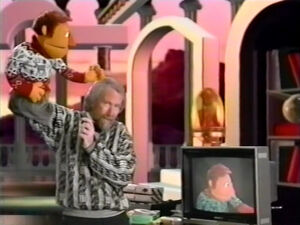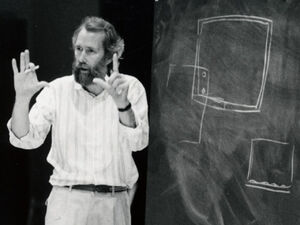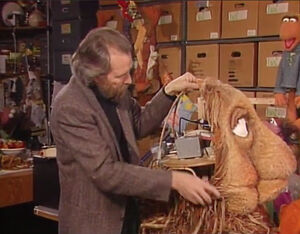
Jim Henson demonstrating the monitor's role in television puppetry in "Secrets of the Muppets."

Henson lecturing on the use of monitors at the Institut International de la Marionnette in 1987.

Gorg-Vision

Caroll Spinney with his monitor strapped to his chest.

High definition monitors in use for Elmo the Musical.
Monitors are a unique tool applied for puppetry in television and film. They allow the puppeteers to see a live view of what the camera is capturing, helping them see where their puppet is within the shot and ensure they keep proper eye focus, as well as making sure the puppeteer is not seen in the frame. Jim Henson is often attributed to developing this technique.
Henson began to employ monitors during his earliest efforts in television puppetry, such as Sam and Friends. While his contemporaries such as Burr Tillstrom (for Kukla, Fran, and Ollie) used the on-set monitors to merely keep an eye on the on-air feed, Henson found how it could instead be used to enhance the performance aspect.
One of the issues raised from this type of performance is that the monitor image appears reversed - "When the puppeteer moves a character to the right, the character moves to the left onscreen."[1] As such, it takes time for newer performers to perfect this process.[2] Sesame Street technician Walt Rauffer once tried to rectify the problem by reversing the image in the monitor, but the seasoned performers found it too difficult to readjust.[3]
The earliest Wilkins Coffee commercials were recorded on 16mm film, which did not allow for an instant monitor playback at the time. As such, Jim and Jane Henson were forced to situate a large mirror just beneath the camera, giving them an approximate view of how the puppets appeared on camera.[4]
For full-bodied characters such as Sweetums or Big Bird, a floor monitor is not visible to the performer inside the puppet. In the case of Big Bird, the performer would wear what Caroll Spinney referred to as "an electronic bra,"[5] where a small playback monitor is strapped to his chest. An alternate technique was devised for the full-bodied Gorgs on Fraggle Rock. A system dubbed "Gorg Vision" places a small television camera in the eye of the Gorgs, which then transmits the picture to a monitor right in front of the suit performers. While this system does not give them a view of what the studio cameras are capturing, it does allow them to move freely without worrying about walking into anything on the set.[6] A similar system was devised for Bear when making public and other television appearances, with a camera fitted in one of his eyes. Two monitors were then used inside the puppet - one showing the eye-camera and the other with the studio camera feed.[7]
Many Muppet Performers (including Henson, Frank Oz, Kevin Clash, Joey Mazzarino, and Matt Vogel) eventually began to tackle duties as directors in addition to puppeteering, often as a result of using the monitor system. Mazzarino recalled, "Puppeteers are directors anyway...it's the only, sort of, performance where you get to see in real-time what your character is doing. So you have an objective eye as well as being the subjective eye."[8]
Sources[]
- ↑ Jim Henson: The Works page 19
- ↑ Sesame Street Puppeteer Workshop (00:17:55)
- ↑ Sesame Street: A Celebration - 40 Years of Life on the Street page 201
- ↑ Sam and Friends: The Story of Jim Henson's First Television Show, 133
- ↑ I Am Big Bird: The Caroll Spinney Story
- ↑ Down at Fraggle Rock: Behind the Scenes
- ↑ Tough Pigs: A Chat with Noel MacNeal, Part 2
- ↑ Below the Frame EP#20: Joey Mazzarino/"Tall Shoes"/Not Puppets (John Kennedy) (01:13:30)
